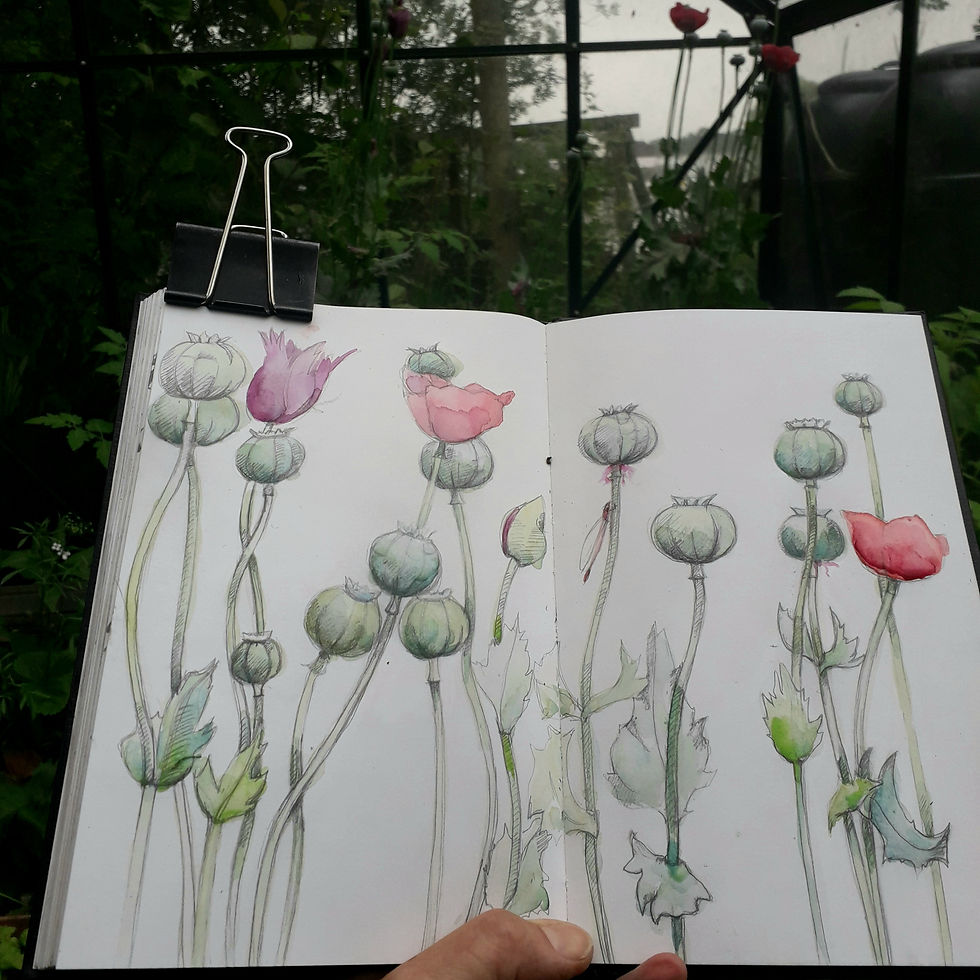Looking at Sketchbooks
- Painter and Printmaker
- Aug 6, 2020
- 4 min read
Updated: Oct 2, 2021

Harvest studies
I have been keeping a sketchbook since my late 20’s and have always found it fundamental to my art practice. Sketchbooks are a safe place to draw. You can experiment with new media, techniques and to simply enjoy drawing. I have a stack of them in my studio, of different sizes and states of dishevelment, with bits of paper pasted in and snips of dried leaves and flowers pressed between pages. But, of late, I have been mulling over how my use of them has evolved and changed, especially since the advent of social media, as I now often have in mind that my sketches will be seen and I have found that I needed to begin to draw again in a more playful and less self-conscious way. So I began to revisit the sketchbooks of favourite artists.

Oak tree study
I have always loved looking at other artist's sketchbooks. One of my earliest art memories is seeing a page of Samuel Palmer’s drawing in my local library as a child and being enchanted by some exquisite sketches of wheat and corn. Like all his sketchbooks, they are heavily notated with his thoughts and colour notes – quite poetic in themselves. This image stayed with me yet it was only recently that I rediscovered the book in which I saw this page and here it is below showing details of harvest fields with detailed notes of wheat and barley both as single specimens and en masse.


Study of Ancient Trees, Lullingstone Park Samuel Palmer
My early sketchbooks were like visual diaries. I would make quick drawings of my home and my cats. I would experiment with media and technique. I would use them to record and observe what I saw in my garden and on my travels. If something didn’t work, no matter, I would turn the page and start afresh. Looking at a small sketchbook of Palmer’s held in the British Museum (link at foot of post), you can see that not all drawings worked, but that they show his thinking processes and the development of his ideas. Of late, I have grown out of this habit and have begun to realise what a loss it is to taking pleasure in drawing for its own sake.
Last year, I went to see a talk by Norman Ackroyd at my local Arts Centre, Diss Corn Hall. He described, with huge enthusiasm and vigour, his sketching trips to the Hebrides and Shetland, about how he would fill book after book, of rapid responses, having several images on the go at once – while one was drying, he would start another. I found this description and process exhilarating.

Similarly the work of Kurt Jackson is equally inspiring. Like Ackroyd, he works in all weathers, with mud and splashes adding to the energetic beauty of the studies. He uses all mediums outside, including acrylic, using whatever he feels will best convey what he sees. Such responsive drawing is thrilling to see.
While preparing this post, I came across a list of materials that Samuel Palmer had written in preparation for a forthcoming sketching trip to Margate in the late summer of 1845:
Put into thick brush case a portcrayon with black and white chalk and a hard and soft pencil. Put into basket at back, a tin box containing reserve colours, and ivory palette. Then throw in the tubes or take them in Mr Walter's box, and upon them, water bottle without case, and dippers to fix upon palettes. Above lay the thick brush case, sketching stool, sketching folio, into which slip the two palettes (large wooden) and two extra pencils: (the above will all slip into red bag). The autumn cloak and umbrella. 1
In contrast to the vast array of materials that accompany Kurt Jackson on his trips by car, I found this neat and compact description of his materials, that would have been carried on his back, touching and couldn’t help wonder what such an experimental artist would have taken with him on drawing trip today.

Amidst the responses to landscape, I love too Kurt Jackson’s small studies of nature that appear in his sketchbooks : a study of a dead vole, tenderly rendered, or the movements of a Swallowtail butterfly and all of these can be found in his book, Kurt Jackson's Sketchbooks. And this leads me to my other favourite observer of nature, Beatrix Potter. Her studies of fungi are so sensitively observed. They are not simply botanical recordings of what she sees, but are imbued with her love and reverence of the subject.

Fungi Studies Beatrix Potter
About to set off for a small drawing trip of my own, I hope to return with a sketchbook full of happy drawing activity and I will return to show you the results in a coming post.

Out in the fields of Fersfield, Norfolk
In the meantime time, I would love to hear of your sketchbook thoughts, or favourite sketchbook artists, in the comments below.
Links and books mentioned:
1. From, "Samuel Palmer: His Life and Work", Raymond Lister.
The sketches of Beatrix Potter
The work of Kurt Jackson
The work of Norman Ackroyd
The work of Vivien Blackburn, landscape artist




the hedgerow you attribute to Kurt Jackson is actually by ME. Take a look at my website vivienblackburn.co.uk - it's part of a series on hedgerows silhouetted against snow as the sun sets